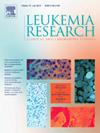Impact of FLT3 inhibitors on the outcomes of FLT3-ITD mutated acute myeloid leukemia following allogeneic hematopoietic stem cell transplant: A systematic review and meta-analysis
IF 2.1
4区 医学
Q3 HEMATOLOGY
引用次数: 0
Abstract
Background
Acute Myeloid Leukemia (AML) with FLT3-ITD mutations is associated with high post-transplant relapse rates. FLT3 inhibitor (FLT3i) maintenance therapy following allogeneic hematopoietic stem cell transplantation (allo-HCT) has emerged as a promising strategy to improve outcomes in this high-risk population.
Methods
We conducted a systematic review and meta-analysis of randomized controlled trials (RCTs) evaluating FLT3i maintenance therapy versus standard of care (SOC) after allo-HCT in patients with FLT3-ITD-mutated acute myeloid leukemia (AML). A comprehensive search of PubMed, Embase, CENTRAL, and ClinicalTrials.gov was performed in accordance with PRISMA guidelines. Primary outcomes included relapse-free survival (RFS), overall survival (OS), and FLT3i-related adverse events. Pooled hazard ratios (HRs) and relative risks (RRs) were calculated using the “meta” package in R (version 4.4.0).
Results
Four RCTs including 701 patients (ages 18–78) met inclusion criteria. FLT3i maintenance significantly reduced relapse (HR 0.50; 95 % CI: 0.34–0.74) and mortality (HR 0.63; 95 % CI: 0.44–0.91) compared to SOC. Hematologic toxicity (RR 2.12; 95 % CI: 1.67–2.70) and chronic GVHD (RR 1.18; 95 % CI: 1.00–1.41) were more frequent in the FLT3i group. Rates of acute GVHD (RR 1.05; 95 % CI: 0.78–1.41) and hepatotoxicity (RR 1.09; 95 % CI: 0.72–1.66) were comparable. Interestingly, skin toxicity was lower with FLT3i (RR 0.36; 95 % CI: 0.16–0.84).
Conclusion
FLT3i maintenance significantly improves RFS and OS in FLT3-ITD-mutated AML post-allo-HCT, though at the cost of increased hematologic toxicity and chronic GVHD. Further studies are needed to define optimal agents, duration, and patient selection to balance efficacy with tolerability.
FLT3抑制剂对同种异体造血干细胞移植后FLT3- itd突变急性髓系白血病预后的影响:一项系统综述和荟萃分析
具有FLT3-ITD突变的急性髓性白血病(AML)与移植后高复发率相关。同种异体造血干细胞移植(alloo - hct)后FLT3抑制剂(FLT3i)维持治疗已成为改善这一高危人群预后的有希望的策略。方法:我们对随机对照试验(RCTs)进行了系统回顾和荟萃分析,这些试验评估了flt3 - itd突变的急性髓性白血病(AML)患者在接受同种异体hct治疗后FLT3i维持治疗与标准护理(SOC)的效果。根据PRISMA指南对PubMed、Embase、CENTRAL和ClinicalTrials.gov进行全面检索。主要结局包括无复发生存期(RFS)、总生存期(OS)和flt3i相关不良事件。使用R(4.4.0版本)中的“meta”包计算合并风险比(hr)和相对风险(rr)。结果4项随机对照试验共纳入701例患者(年龄18-78岁)。维持FLT3i可显著降低复发(HR 0.50;95 % CI: 0.34-0.74)和死亡率(HR 0.63;95 % CI: 0.44-0.91)。血液学毒性(RR 2.12;95 % CI: 1.67-2.70)和慢性GVHD (RR 1.18;95 % CI: 1.00-1.41)在FLT3i组中更为常见。急性GVHD发生率(RR 1.05;95 % CI: 0.78-1.41)和肝毒性(RR 1.09;95 % CI: 0.72-1.66)具有可比性。有趣的是,FLT3i的皮肤毒性较低(RR 0.36;95 % ci: 0.16-0.84)。结论维持flt3i可显著改善同种异体hct后flt3 - itd突变AML患者的RFS和OS,但代价是血液学毒性增加和慢性GVHD。需要进一步的研究来确定最佳药物、持续时间和患者选择,以平衡疗效和耐受性。
本文章由计算机程序翻译,如有差异,请以英文原文为准。
求助全文
约1分钟内获得全文
求助全文
来源期刊

Leukemia research
医学-血液学
CiteScore
4.00
自引率
3.70%
发文量
259
审稿时长
1 months
期刊介绍:
Leukemia Research an international journal which brings comprehensive and current information to all health care professionals involved in basic and applied clinical research in hematological malignancies. The editors encourage the submission of articles relevant to hematological malignancies. The Journal scope includes reporting studies of cellular and molecular biology, genetics, immunology, epidemiology, clinical evaluation, and therapy of these diseases.
 求助内容:
求助内容: 应助结果提醒方式:
应助结果提醒方式:


